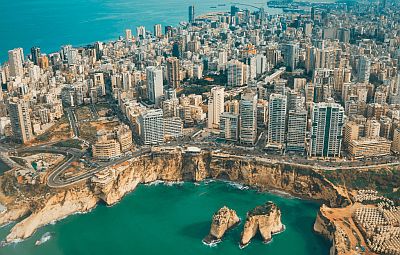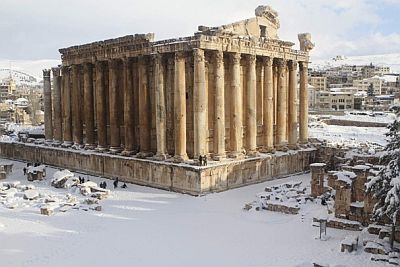Select units of measurement for the temperature and rainfall tables (metric or imperial).
Average weather, temperature, rainfall, sunshine
In Lebanon, a small country in western Asia, the climate is
Mediterranean on the coast, with mild and rainy winters and hot and sunny summers.
In the interior, occupied by mountain ranges and valleys, the climate is more
continental, in fact winters become progressively colder with increasing altitude, while summers are very hot in the areas below 1,000 meters (3,300 feet).
The
rains follow the Mediterranean pattern, in fact they only occur between October and April (and sometimes in May), and are more abundant in winter. This pattern is followed even in the interior, although the rainfall is scarcer in the eastern part of the country.
From June to September, it almost never rains, and the sun shines everywhere.
In spring, and more rarely in autumn, Lebanon can be affected by a strong
desert wind, called
Khamsin, which can cause sudden increases in temperature and bring sandstorms.
The climate in detail
The coast
On the Lebanese
coast, where
Beirut, the capital, is found, plus other cities such as
Tripoli, Sidon and Tyre, the climate is Mediterranean.
Rainfall is more abundant in the north, in fact it ranges from 850 millimeters (33.5 inches) per year in Tripoli (in the north), to 730 mm (28.5 in) in Beirut (in the center), to 600 mm (23.5 in) in Tyre (in the south).
 Winter
Winter, from December to February, is very mild, with an average January temperature of 13/14 °C (55/57 °F). There are sunny periods, however, there are also periods of bad weather, with wind, rain and thunderstorms, sometimes accompanied by hail.
Sometimes there can be
somewhat cold periods, with lows close to freezing and highs of around 10 °C (50 °F).
Snow on the Lebanese coast is very rare in the north (see Tripoli), where it occurs once every ten years, and extremely rare in the center-south (see Beirut, Tyre), where it has not occurred for decades.
Summer, from June to September, is hot, muggy and sunny. The average temperature in August, the hottest month, is around 28 °C (82.5 °F). The humidity is high, although the sea breeze provides some relief. Rainfall is very rare, especially in July and August, when it basically never rains.
The temperature can reach or exceed 37/38 °C (99/100 °F) from April to October, usually for short periods, when the wind blows from the desert.
The
sea in Lebanon is warm enough to swim in from June to October or November.
Inland areas
Mount Lebanon
On the range of Mount Lebanon, parallel to the coast, the
winter rains are even more abundant than on the coast, at least on the western slope, the one directly exposed to maritime currents, which are forced to rise and condense in clouds.
The temperature naturally decreases with increasing altitude, so in winter these mountains experience
heavy snowfalls, and in the worst winters, large amounts of snow can fall. Snow covers the mountains above 2,000 meters (6,500 feet) for almost 4 months a year, and above 2,500 meters (8,200 feet) for about 6 months a year.
Mount Lebanon is the highest chain in the country, culminating in
Qurnat as Sawda', 3,087 meters (10,128 feet) high.
At 2,000 meters (6,500 feet) above sea level, in the
Cedars Ski Resort, located in the north of the country, east of Tripoli, the average temperature in January is about 0 °C (32 °F), while that of July and August is 18/19 °C (64/66 °F).
Bekaa Valley
Further east, in the Bekaa Valley, located between the chains of Lebanon and Anti-Lebanon, and at an altitude ranging between 600 and 1,200 meters (2,000 and 3,900 feet), the climate can be considered
continental Mediterranean. Winter is colder than on the coast, also because of the altitude, while summer is hot, despite the altitude.
For example, in
Zahlé, the capital of the Bekaa governorate, located at 950 meters (3,100 feet) above sea level, the average temperature ranges from 7 °C (44.5 °F) in January to 26.5 °C (79.5 °F) in August.
Precipitation is concentrated in the winter months here as well, and it's a bit less abundant than on the coast or on the western slope, but it is nonetheless significant, around 100/150 mm (4/6 in) per month from December to February.
When cold spells affect Lebanon and the Middle East in winter, abundant
snowfalls may occur, followed by frosts.
In summer, the days are
hot, sometimes scorching, but nights are still quite cool because of the altitude, especially in the highest part of the valley, such as in Baalbek, located at 1,200 meters (4,000 feet) above sea level.

In the eastern part of the country, we find the
Anti-Lebanon mountain range, which is cold in winter but more arid, especially in the northern part, while in the south, near Mount Hermon, heavy snowfalls can occur in winter.
When to go
The best times to visit Lebanon are
spring and autumn: you can visit the coastal cities, including Beirut, and the Bekaa Valley as well, in April-May and September-October, bearing in mind that in the Bekaa Valley, in April and October nights are very cool or even cold.
For a
beach holiday, you can go from mid-May to mid-October, although the sea reaches 24 °C (75 °F) only in June.
What to pack
In
winter: for Beirut and the coast, bring spring/autumn clothes, a sweater and a jacket, a raincoat or umbrella. For the Bekaa Valley: bring warm clothes, a down jacket, a beanie, an umbrella or raincoat, hiking shoes; for the highest mountain, mountain clothing.
In
summer: for Beirut and the coast, bring light clothing, a light sweatshirt for the evening. For the Bekaa Valley, light clothes, a sun hat, a sweatshirt or sweater for the evening, a scarf, hiking shoes; a sleeping bag for outdoor overnight stays. For the highest mountain, a jacket and a sweatshirt.
Climate data - Lebanon
| Ariz (2,000 meters) |
|---|
|
| Jan | Feb | Mar | Apr | May | Jun | Jul | Aug | Sep | Oct | Nov | Dec |
|---|
| Min temp. | -2 | -3 | -1 | 1 | 6 | 10 | 15 | 13 | 11 | 6 | 3 | 0 |
|---|
| Max temp. | 2 | 2 | 5 | 9 | 15 | 20 | 22 | 22 | 19 | 15 | 12 | 6 |
|---|
|
|
|
|
|
| Beirut |
|---|
|
| Jan | Feb | Mar | Apr | May | Jun | Jul | Aug | Sep | Oct | Nov | Dec |
|---|
| Min temp. | 11 | 11 | 13 | 15 | 19 | 22 | 24 | 25 | 24 | 21 | 17 | 13 |
|---|
| Max temp. | 18 | 18 | 20 | 23 | 26 | 29 | 31 | 31 | 30 | 28 | 24 | 20 |
|---|
| Precip. | 155 | 125 | 85 | 30 | 10 | 0 | 0 | 0 | 5 | 60 | 115 | 140 |
|---|
| Prec. days | 12 | 10 | 8 | 5 | 2 | 2 | 0 | 0 | 1 | 4 | 7 | 11 |
|---|
| Humidity | 63% | 63% | 63% | 64% | 67% | 69% | 70% | 69% | 64% | 60% | 57% | 61% |
|---|
| Day length | 10 | 11 | 12 | 13 | 14 | 14 | 14 | 13 | 12 | 11 | 10 | 10 |
|---|
| Sun hours | 4 | 5 | 6 | 8 | 10 | 12 | 12 | 11 | 10 | 8 | 7 | 5 |
|---|
| Sea temp | 18 | 17 | 17 | 18 | 21 | 24 | 27 | 28 | 28 | 26 | 23 | 20 |
|---|
| Zahlé (950 meters) |
|---|
|
| Jan | Feb | Mar | Apr | May | Jun | Jul | Aug | Sep | Oct | Nov | Dec |
|---|
| Min temp. | 2 | 3 | 6 | 9 | 12 | 16 | 18 | 18 | 16 | 12 | 7 | 4 |
|---|
| Max temp. | 12 | 14 | 17 | 22 | 28 | 32 | 34 | 35 | 32 | 27 | 20 | 14 |
|---|
| Precip. | 155 | 135 | 85 | 40 | 10 | 0 | 0 | 0 | 5 | 30 | 70 | 120 |
|---|
| Prec. days | 12 | 10 | 9 | 5 | 2 | 0 | 0 | 0 | 1 | 4 | 7 | 10 |
|---|
|
|
|
|
See also the
temperatures month by month